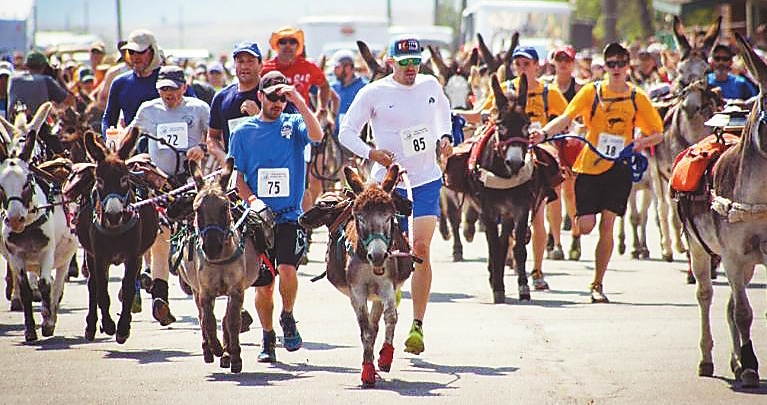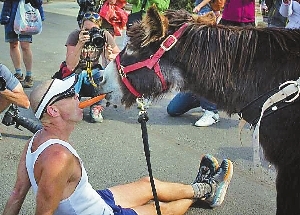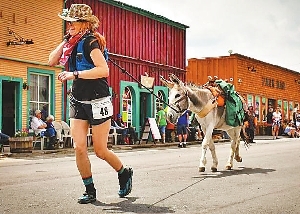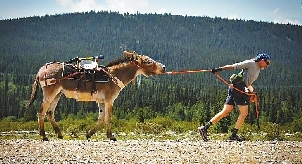



CONSIDER the glorious but humble donkey. According to the Bible, Jesus rode one, not a horse, into Jerusalem. Burros, as the Spanish call them, walk at about a human’s foot speed. They rarely kick or bite. They seem to have a calming effect on horses and humans. Like a cross between a Tesla and a wheelbarrow, donkeys are beasts of burden that can carry up to 136 kilograms for more than two weeks in the mountains while needing very little food or water. They’re sort of the camels of the West. In fact, they’re the camels of the East, North and South, too, as donkeys continue to thrive in North and South America, Europe, Asia and Africa. When the U.S. mining industry started to dry up in the 1930s and ‘40s, some enterprising Coloradans came up with the idea of attracting spectators to their towns by hosting an ultramarathon of human-donkey pairs — The World Championship Pack Burro Race. “They teach us so much,” said pack burro race director Brad Wann. “They teach us humility. They connect us with nature. Burros have the ability to reach into your soul.” The first race was in 1949, which makes it, according to Wann, the second-oldest continuously run marathon in the United States after the Boston Marathon. The race also lends itself to a variety of puns. For example, the winner of the annual pack burro championship is the first to “get his or her ass over the finish line.” Wann’s title is media relations officer for the Western Pack Burro Ass-ociation. But it’s still a serious sport, even if it has a sense of humor. “Haulin’ Ass” is the title of a very straight documentary about the sport. A burro-ful day Originally the race extended between Leadville and Fairplay, located in the middle of the state and only about 17.6 km apart as the crow flies, but separated by a mountain. Legend holds that it was inspired by two miners who struck gold simultaneously and raced back to town to claim the find. The real story is that the race was inspired by a desire to keep former mining towns from turning into ghosts. Now both towns have their own races, part of an annual series of eight in Colorado. Fairplay is the longest (46.4 km), tied for highest (more than 3,962 meters), and the one that retained the World Championship title. The town is also home to the Prunes Monument, possibly the only monument in the world erected to honor a donkey. Prunes worked alongside a miner for more than 60 years. Running with a donkey is a bit of give and take, literally. Sometimes you’re pulling them; other times, they’re pulling you. On flat trails, either teammate can be in the lead, or side-by-side, but human runners are still doing the steering. Gear-wise, runners need the right shoes, clothes, running vests and fuel for an ultramarathon. And the burros, in addition to getting a clean bill of health from a vet, need the old timey mining equipment and added weight to carry. Injuries are possible As with any ultramarathon trail run, injuries are always possible. According to a 2015 study involving 1,212 active ultrarunners, they suffered about the same frequency of injuries as shorter-distance runners, though some wounds were inflicted by the obstacles of trail running. The most common injuries were knee and foot stress fractures. Being tethered to a donkey adds risk of injury to runners, of course. If you trip, you can get serious road rash from getting dragged along. One year a runner bruised or broke some ribs when her burro kicked her in the chest. The rules don’t allow runners to ride the donkey, but in the race’s history, injured runners have been carried down the mountain on their partners’ back, as they’re out of the race anyway. Donkeys get injured too, but in 70 years of racing, not one animal has died or been injured beyond recovery. Organizers also point out that donkeys enjoy the race as much as the ultra-runners. “If you observe donkeys in the wild, they aren’t sedentary creatures,” wrote Western Pack Burro Ass-ociation member Sheri L. Thompson on the sport’s race website. “In the wild, donkeys are very trim athletic animals” and “they exercise all day long.” “They are willing participants,” Thompson writes, alluding to the burro’s famous stubbornness. “If they don’t want to go, you can’t make them do anything.” (SD-Agencies) | 
